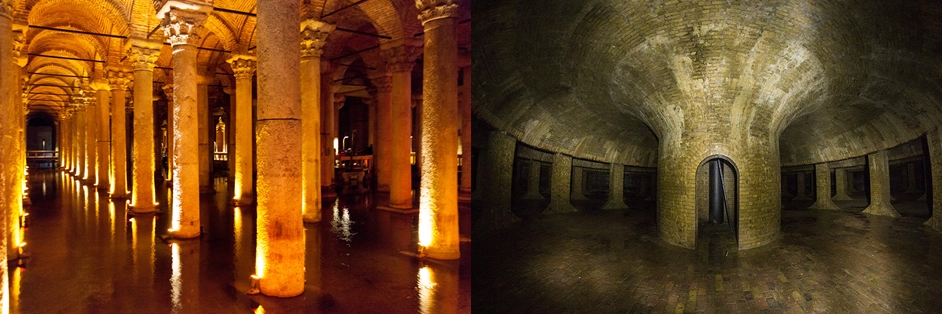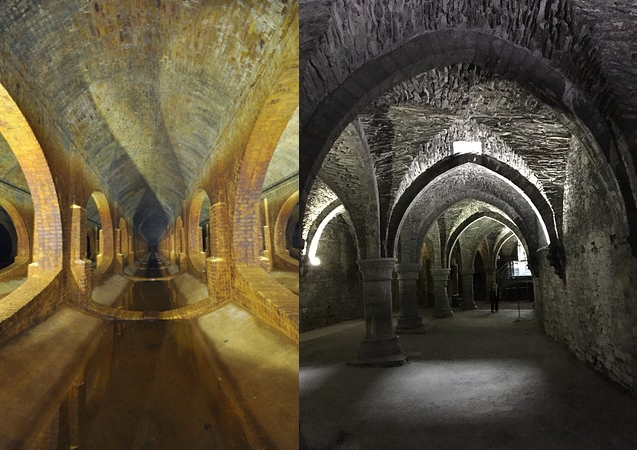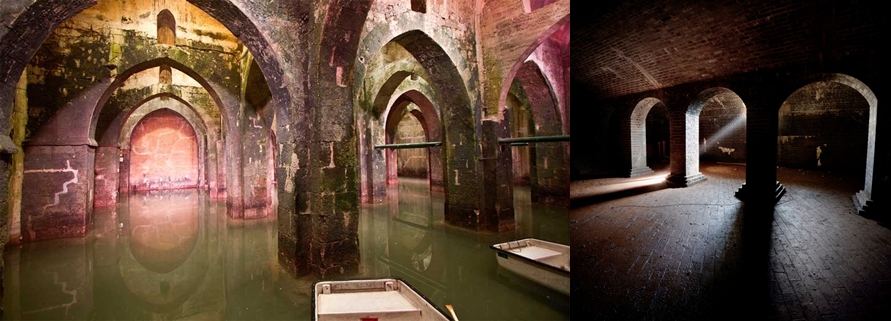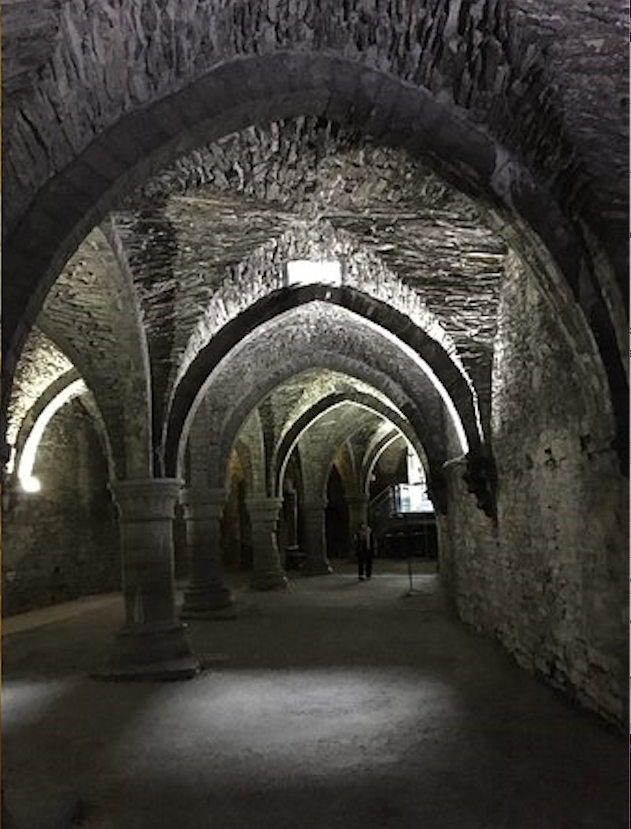In Part 1 “Going Underground” I proffered the suggestion that the underground reservoir near Papplewick Pumping Station was more ancient than the official narrative would have us believe. That narrative states that a firm from Wolverhampton was employed by the Nottingham Authorities to build the massive reservoir required by the pumping station. In and of itself, that is a dubious suggestion on the simple basis that the most logical appointment would have been a local firm of architects and builders, familiar with the geology of the region and the topography of the land.
As if that is not enough, there are other logistical questions that cannot be answered.
Was it really possible for a firm of builders, from another county, using only donkeys, horses and carts and hand tools to dig out the site, line it with clay and then use 100s of thousands of red bricks to construct a magnificent reservoir that was then covered? And, equally, significantly, how was it possible that the purported building works were completed in 1879, in less than 9 months?
These sorts of questions cannot be answered by the mainstream narrative, as promulgated by Wikipedia, amateur historians and the guides who take visitors to view the underground reservoir.
In response to the first part. an associate emailed me the following information, taken from the site, Entity Art, to which credit is duly given,
Underground Reservoirs
The vast majority of these Old-World under-city reservoirs would have likely been buried by the mud flooding, and the melting of buildings, that I showed you occurred in previous articles in this series – in what was a large scale moulding and destruction of the Old-World infrastructure in Earth’s more distant history. Old World buildings all around the world are partially buried, so many reservoirs would have likely been filled in with dirt / mud. They would also be cut off from the water supplies that filled them, which could have been from manmade over-ground or underground rivers.
The water ways (both above and below ground), and canals systems, that we have all over our land masses, would have nearly all been built by these Old-World builders (giant humans). Source
There is nothing in that that I would take issue with. By way of example, the author includes the following images
Images from around the world of underground reservoirs:



It is a case of stating the obvious that all archeology is based on the presumption that buried artefacts have to be dug out but why don’t any of the archeologists ever ask the questions,
How were they buried?
Who really built them?
When were they really built?
Why do so many buildings have foundation stones? Were the glorious buildings already there, found and dug out to be repurposed?
Or were they genuinely built by the townsfolk of the 18th Century using the Big Horse and Donkey Services Inc at a time when there were no power tools, the roads were invariably mud-deep in Winter and dusty in Summer? That those grand feats of architecture were completed in a matter of months or a year or so? And, from where were all the skilled craftsmen and master stonemasons required for such undertakings at a time when the populations of the world were very low? Where were they trained?
That is the logistical connundrum on which the official narrative always falls.
My take? That our history is a lie, covering up the fact that our buildings are ancient and not built by the stove-pie-hatted Victorians, backed up by huge armies of flat-capped navvies from Ireland.
Which also brings into question the construction of thousands of miles of canals across the British Isles by the same navvies using nothing but pick-axes, spades and muscle.
To be continued.
A special thank-you to Steve Hirst for providing this additional information and to the excellent EntityArt website for the photographs.
Thanks, also, to my discerning readers and viewers, whose appreciation is highly valued.
Should anyone wish to express his/her appreciation, then please use the Buy Me a Coffee button and leave me a comment – I will get back to you.
I can also be found on Substack, should you frequent that platform.





September 23, 2024
It says 11th Century to me now most if not all of the stone looks within the 20kilo mark bar the pillars(Norman Arch).
Its worth noting that this is near Nottingham , the river trent is navigable and there is most absolutely an ancient waterway(perhaps old swamp is more appropriate) to the north leading to the village of Papplewick from the Bestwood County mill Park with the seasonal River Leen which has shifted its course to the duck ponds & the goosedale sport club into Blidworth woods where the pumping stations is.
Your donkeys in ancient England had a wee bit less distance to travel than you think for most of it, and if you go by William George Hoskins most of your Dane/Saxon settlements was on the the riverbanks(an in wooden dwellings) About 40ft in this instance from the river.
https://www.google.com/maps/d/viewer?mid=16YO0z0rYwWTKdJ3yBChPnZvaMRo&ie=UTF8&t=h&oe=UTF8&msa=0&ll=53.0605335357509%2C-1.1315112757148404&z=15
Your stone building was their monument built over centuries. There is obviously early Norman arches & it lacks the gothic polished finish(so there was a large settlement )
In detraction
The concept that most of Britain was built in hard to get to places by giants ignores that fact that even giants find the lazy way to do stuff. The limestone outer of the Pyamids for instance have only within the last 15 years been discovered to have been made by blocks of lime cement. Egyptologists still have this hang up on slaves in a Nation which never had slaves(but seasonal workers) to move giant blocks over a 14,000 year old step pyramid build when Orions belt was flipped because Syrius was our closest star in its long orbit and there was no true night. (those who believe in the book believe only in the book whcih has a 5000 year old earth and not the evidence, which is upsetting even to ardent scientists who themselves have come to believe in something wrong)
The land would have shifted some, even with the water extraction by the pumping house, and if you remember your geography its still moving up after the ice loss and its been 1000 years, my guess is there has also been significant unrecognised movement with the Pennines changing the water courses.
A good clue is if you search Papplewick and Monestery and you find its one of the most ancient settlements in the country from the Saxon era with a stone church, it was under Lenton Abbey until Henry II gifted it to the St Augustine order who built a new abeey about a mile N/W of Papplewick called Newstead(i.e. some significant building industry was there to build said monestery – for the era)
Regards
September 23, 2024
Thank you very much for this excellent information, David, and for taking the time to comment. It’s interesting you mention the Goosedale Sports club as I used to play hockey there for Nottingham Hockey Club until I retired from the sport in 2009.
Your references to the underground reservoir exhibiting architectural traits of Norman influence is most interesting, but, being a simulationist, I do not share the uniformitarian view of this realm, which includes the unverifiable notion of anything being dated to tens of thousands of years ago or indeed that the landscape has been sculptured by huge ice-ages.
These days, when I visit some of the landscapes of the Peak District, I no longer view the stones atop Kinder Scout or Burbage as being mere natural anomalies but rather material evidence of an ancient culture that built these huge structures that were demolished by way of catastrophic event(s). The existance of giants is unassailable, given the material evidence of the skeletons that have been unearthed around the isles of Britain, alone. I am of the view that under a vapour canopy, all men, flora and fauna grew to great sizes. Were our ancestors once giants? It is certainly possible.
Once again, thank you for your valued insights.
September 26, 2024
Check out TELLURIC CURRENT And check out Liverpool Cathedral